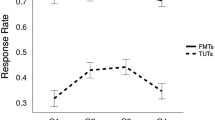Abstract
When a person tries to suppress a thought, environmental features are often used as distracters. This research examined whether such distracters later become reminders of the unwanted thought when suppression is discontinued — and so incline the individual who remains in the suppression environment to experience a rebound of preoccupation with the unwanted thought. Subjects were asked to think aloud and to signal with a bell ring any thoughts of white bears. They were directed either to think or not to think of white bears in one context (a slide show). When they were then invited to think about white bears in a different slide-show context, no appreciable rebound of white bear thoughts was found in the subjects who had initially suppressed. However, when they were issued the same invitation on return to the initial context, those who had initially suppressed showed a rebound of preoccupation.
Similar content being viewed by others
References
Burstein, S., & Meichenbaum, D. (1979). The work of worrying in children undergoing surgery.Journal of Abnormal Child Psychology, 7 127–132.
Foa, E. B., & Kozak, M. J. (1986). Emotional processing of fear: Exposure to corrective information.Psychological Bulletin, 99 20–35.
Freud, S. (1958). Remembering, repeating, and working-through. In J. Strachey (Ed.),The standard edition of the complete psychological works of Sigmund Freud (Vol. 12, pp. 145–150). London: Hogarth Press (Original work published 1914).
Janis, I. L. (1958).Psychological stress. New York: Wiley.
Lazarus, R. S. (1983). The costs and benefits of denial. In S. Breznitz (Ed.),The denial of stress (pp. 1–30). New York, International Universities Press.
Lindemann, E. (1944). Symptomatology and management of acute grief.American Journal of Psychiatry, 101 141–148.
Pennebaker, J. W. (1989). Confession, inhibition, and disease. In L. Berkowitz (Ed.),Advances in experimental social psychology (Vol. 22, pp. 211–244). San Diego, CA: Academic Press.
Polich, J. M., Armor, D. J., & Braiker, H. B. (1981).The course of alcoholism. New York: Wiley.
Polivy, J., & Herman, C. P. (1985). Dieting and binging: A causal analysis.American Psychologist, 40 193–201.
Pope, K. S. (1978). How gender, solitude, and posture influence the stream of consciousness. In K. S. Pope & J. L. Singer (Eds.),The stream of consciousness (pp. 259–299). New York: Plenum Press.
Rachman, S. (1980). Emotional processing.Behaviour Research and Therapy, 18 51–60.
Silver, R. L., Boon, C., & Stones, M. H. (1983). Searching for meaning in misfortune: Making sense of incest.Journal of Social Issues, 39 81–102.
Smith, S. M. (1988). Environmental context-dependent memory. In G. M. Davies & D. M. Thomson (Eds.),Memory in context: Context in memory (pp. 13–34). Chichester, U.K.: Wiley.
Tulving, E., & Thomson, D. M. (1973). Encoding specificity and retrieval processes in episodic memory.Psychological Review, 80 352–373.
Wegner, D. M. (1988). Stress and mental control. In S. Fisher & J. Reason (Eds.),Handbook of life stress, cognition, and health (pp. 685–699). Chichester: Wiley.
Wegner, D. M. (1989).White bears and other unwanted thoughts. New York: Viking Press.
Wegner, D. M., & Erber, R. (1991). The hyperaccessibility of suppressed thoughts. Manuscript submitted for publication.
Wegner, D. M., & Schneider, D. J. (1989). Mental control: The war of the ghosts in the machine. In J. Uleman & J. Bargh (Eds.),Unintended thought (pp. 287–305). New York: Guilford Press.
Wegner, D. M., Schneider, D. J., Carter, S., & White, T. (1987). Paradoxical effects of thought suppression.Journal of Personality and Social Psychology, 55 1–9.
Wegner, D. M., Shortt, J. W., Blake, A. W., and Page, M. S. (1990). The suppression of exciting thoughts.Journal of Personality and Social Psychology, 58 409–418.
Wenzlaff, R., Wegner, D. M., & Roper, D. (1988). Depression and mental control: The resurgence of unwanted negative thoughts.Journal of Personality and Social Psychology, 55 882–892.
Author information
Authors and Affiliations
Additional information
This research was supported in part by National Science Foundation grant BNS 88-18611. We thank Sara Dimitri, Victor Herrera, Mark Mitchell, and Joann Wu Shortt for their assistance in the conduct of this research and Mary Dozier, Stan Klein, Toni Wegner, and Richard Wenzlaff for their helpful suggestions. Brian Knutson is now at Stanford University.
Rights and permissions
About this article
Cite this article
Wegner, D.M., Schneider, D.J., Knutson, B. et al. Polluting the stream of consciousness: The effect of thought suppression on the mind's environment. Cogn Ther Res 15, 141–152 (1991). https://doi.org/10.1007/BF01173204
Issue Date:
DOI: https://doi.org/10.1007/BF01173204




